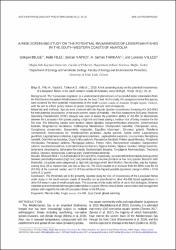A RISK SCREENING STUDY ON THE POTENTIAL INVASIVENESS OF LESSEPSIAN FISHES IN THE SOUTH-WESTERN COASTS OF ANATOLIA
Özet
Background. The 'Lessepsian migration' is a unidirectional phenomenon of successful biotic colonisation from the Red Sea into the eastern Mediterranean Sea via the Suez Canal. In this study, 45 Lessepsian marine fish species were screened for their potential invasiveness in the south-western coasts of Anatolia (Mugla region, Turkey), with the aim to inform policy makers on proper management and control measures. Materials and methods. Species were screened with the Aquatic Species Invasiveness Screening Kit (AS-ISK) for their potential invasiveness in the south-western coasts of Anatolia-the Risk Assessment (RA) area. Receiver Operating Characteristic (ROC) analysis was used to assess the predictive ability of AS-ISK to discriminate between the Lessepsian fish species posing a high risk and those posing a medium risk of being invasive for the RA area. The following species were studied: Alepes djedaba, Apogonichthyoides pharaonis, Atherinomorus forskalii, Bregmaceros nectabanus, Callionymus filamentosus, Champsodon nudivittis, Champsodon vorax, Cynoglossus sinusarabici, Du.ssumieria elopsoides, Equulites klunzingeri, Etrumeus golanii, Fistularia commersonii, Hemiramphus far, Herklotsichthys punctatus, Jaydia queketti, Jaydia smithi, Lagocephalus guentheri, Lagocephalus sceleratus, Lagocephalus spadiceus, Lagocephalus suezensis, Liza carinata, Nemipterus randalli, Ostorhinchus fasciatus, Oxyurichthys petersii, Parupeneus forsskali, Pe fates quadri lineatus , Pempheris rhomboidea, Pomadasys stridens, Pteragogus pelycus, Pterois miles, Rachycenttrm canadum, Satgocentron rubrum, Saurida lessepsianus, Scomberomorus commerson, Siganus luridus, Siganus rivulatus, Sillago suezensis, Sphyraena chrysotaenia, Sphyraena flovicauda, Stephanolepis diaspros, Torquigener flavimaculosus, Trachurus indicus, Upeneus moluccensis, Upeneus pori, Vanderhorstia mertensi. Results. BRA and BRA +CCA thresholds of 18.5 and 29.5, respectively, were identified that reliably distinguished between potentially invasive (high risk) and potentially non-invasive (medium or low risk) species. Based on both thresholds, 14 species were categorised as high risk (amongst which devil firefish, Pterois miles, was the highestscoring one), 28 as medium risk, and one as low risk. The CCA resulted in an increase from the BRA score for 42 (93.3%) of the screened species, and 12 of these achieved the highest possible (positive) change in BRA + CCA score of 12 points. Conclusion. The thresholds set in the presently reported study for risk of invasiveness of the Lessepsian fishes under study in the south-western coasts of Anatolia can be transferred to other AS-ISK based applications in other RA areas in case of small sample sizes. The outcomes of this study will be of use to fish biologists, fisheries scientists and environmental managers/stakeholders in a joint effort to ensure better conservation and management actions with regard to the role of Lessepsian fishes in the RA area.


















